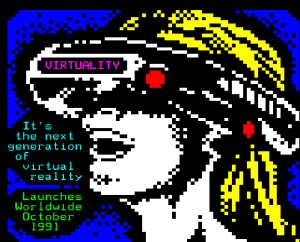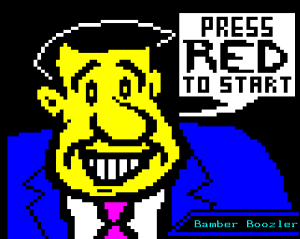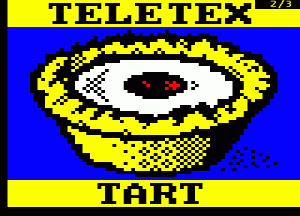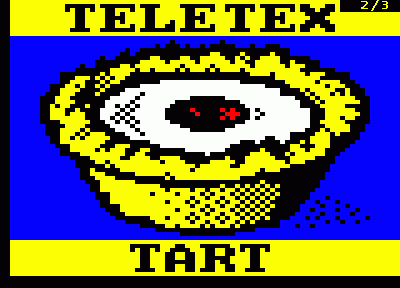It’s one of the great ironies of our time that the twenty-first century – envisaged as a space-age era of flying cars and underwater cities – loves nothing better than a bit of dewy-eyed gazing at the twentieth century.
One man who may be able to tell you that better than most is digital artist Dan Farrimond (http://danfarrimond.co.uk), who specialises in adapting one of the most iconic pre-internet technologies into an unlikely source of creative output.
As it happens, The Indiependent managed to fire him over some questions about just that, as well as the method and technique behind the little-known-yet-thriving craft of Teletext art. Delta International Recruitment Agency in Pakistan
THE INDIEPENDENT: As niches go, Teletext-style art is quite a snug one. How did you get into creating these pieces?
It’s funny, really. Despite using teletext every day for about 10 years of my life, I never even considered how pages were made until  I found a free editor online. Which I played around with for a month or so, then left alone for many years.
I found a free editor online. Which I played around with for a month or so, then left alone for many years.
But in 2012, I noticed a call for entries for this exciting new thing called the International Teletext Art Festival. Picking up the teletext editing program again, I spent a week creating lots of silly experiments to submit.
Of course, I didn’t expect them to publish all ten of them! They set a limit of 5 entries per artist for subsequent ITAFs, probably to stop me doing the same again…
However, following ITAF12 I was invited to design some teletext pages for a UK cable service. And it all gathered momentum from there.
THE INDIEPENDENT: Talk me through the creative and practical process behind your work.
What I like most about teletext is that it’s (almost) impossible to overcomplicate things – the process of making a page is relatively quick. But the downside is that you can’t always be certain what’s going to work, and it could take two or three attempts to make your portrait of Wayne Rooney actually look like him. Or as much as it can on an 80×72 pixel grid, anyway.
Likewise, it could just as easily take fifteen minutes.
Myself, I prefer to compose pages in image editing software then import them to the teletext editor. This is where I add colour, text and special teletext functions like double height or flashing graphics.
…and after all that, it could still look ruddy awful! Luckily, there’s a certain acceptance that it has to be ‘a bit crap’, because that’s what makes teletext great.
THE INDIEPENDENT: What tends to be the typical reaction to what you do?
People who used teletext have mostly forgotten about it, so it reminds them of a time before the internet took over. They tell me stories about ‘watching’ football matches on teletext, or how it was possible cheat at the teletext quiz Bamboozle.
So the reaction is almost always a nostalgic one, even if people’s memories of teletext are bad – those pages used to take an awfully long time to load!
Kids of the post-teletext generation also pick it up surprisingly well. It’s all very simple to someone who’s grown up with hyperlinks and homepages – things teletext was using long before the World Wide Web was spun. Well, kind of.
And isn’t teletext just the Minecraft of the 80s? Well, kind of.
Above all, teletext should be fun. I like to think people look at these pages and smile. I know I still do.
THE INDIEPENDENT: It’s been a while since anyone in Britain has seen the likes of Ceefax grace their screen. What about its ‘retro’ aesthetic do you think lends itself to art?
 From a personal point of view, teletext suits my own philosophy of keeping things simple… or maybe it’s the other way round, and teletext shapes my philosophy?
From a personal point of view, teletext suits my own philosophy of keeping things simple… or maybe it’s the other way round, and teletext shapes my philosophy?
Whatever the case, I think teletext art is very achievable and accessible. Like a good video game, it’s easy to pick up and play. You’d never be able to compose the Mona Lisa after just an hour of painting tuition, but you could create something artistically competent within 60 minutes of learning teletext editing software.
It’s true – I’ve seen it happen before my very eyes at teletext art workshops!
It’s also fun to discover the unexplored potential of teletext as an artform. Ceefax and friends had strict broadcasting guidelines to adhere to, whereas the internet is a lot more liberal. And I’m not just talking about the naughty words.
THE INDIEPENDENT: Do you reckon the everyday technology of the 2010s will be similarly revisited in 30 years time?
Most definitely! It’s the cycle of technology – as one medium dies out commercially, the public re-appropriate it. Old video games are emulated on new platforms, fashionistas are attracted to ‘brick’ mobile phones, DJs consume vinyl records like it’s 1977.
I’m fairly sure 2010s tablet PCs will be sought after in 30 years’ time, if only because they’ll have become cheap enough to buy and experiment with. I mean, people are naturally reluctant to hack a £500 iPad to bits, but given time…
THE INDIEPENDENT: What would you say has been the highlight of your career so far? And what can we expect in the future?
Oh, nothing can ever beat having letters published on teletext in the 1990s! That buzz of having your stuff broadcast to millions is unparalleled.
I enjoyed hosting a teletext art workshop at Tate Britain, though. It was almost as big a buzz to place teletext alongside the classic masterpieces in a London gallery for the first time (that I am aware of), even if just for a day.
Most of all, that event reminded me that art should be about people, and the stories behind the people. And as a social medium, teletext embodies those.
On that note, going forward I would like to create something on a much larger scale. To host a full-fat 500-page teletext service, or maybe produce a 2-hour documentary about the medium. I want to bring teletext back to the masses again. There are plenty of teletext voids to be filled yet, I think.
THE INDIEPENDENT: And finally: what’s your favourite artwork of your own, and of all time?
Well, I’ll have to be predictable and pick the Teletextart. I just love terrible puns, and the combination of blue and yellow reminds me of that iconic Teletext Ltd. ‘home page’ banner. I’ve probably made more interesting things technically, but I’m sure this is the one they’ll broadcast on the teletext television above my grave.
 As for other teletext artists, I particularly like the work of Raquel Meyers and Max Capacity. I’m not ashamed to say I’ve appropriated many elements of teletext design from those guys! If they’re reading, I’d like to thank them.
As for other teletext artists, I particularly like the work of Raquel Meyers and Max Capacity. I’m not ashamed to say I’ve appropriated many elements of teletext design from those guys! If they’re reading, I’d like to thank them.
But I also have a soft spot for the cartoons of Mr Biffo – I’m fairly sure these were the first bits of teletext art I ever saw, so they must certainly be an influence. Turner the Worm is still a joy to read… or should that be ‘watch’? Teletext is on television, after all…
But to pick a favourite artwork of all time… is too difficult a task! Instead, I think I’ll go with something I enjoyed this week, and that’s Dylan Barry’s artwork for his Steam title ‘Uriel’s Chasm 2′. With Dylan’s games, you always know you’re going to face a gargantuan pixel monster right at the end, and that’s worth the admission fee alone.
More of Dan Farrimond’s work can be found over at http://danfarrimond.co.uk/ and http://teletext art.tumblr.com
Interview by Benedict Tetzlaff-Deas
